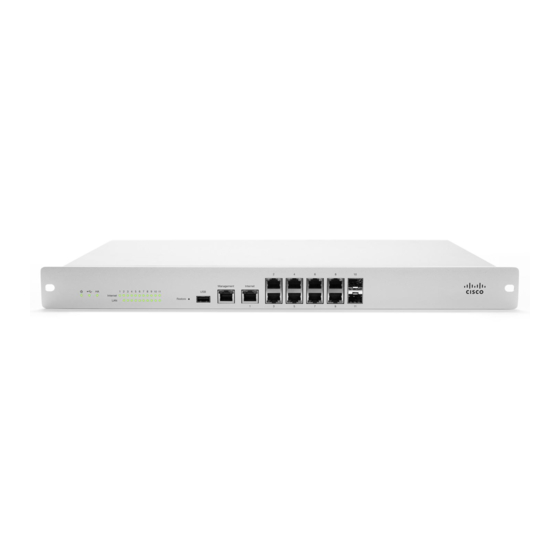
Advertisement
MX100 Installation Guide
This document describes how to install and set up the MX100 security
appliance. Additional reference documents are available online at:
www.meraki.com/library/products.
MX100 Overview
The Meraki MX100 is an enterprise security appliance designed for
distributed deployments that require remote administration. It is ideal for
network administrators who demand both ease of deployment and a
state-of-the-art feature set. This security appliance provides the
following new features:
• Two GbE SFP connections (requires optional Meraki SFP-1GB-SX
transceiver).
• USB port, to support approved 3G/4G cards for failover to cellular
networks.
• 1TByte cache storage for WAN acceleration.
• LAN 2 port can be configured to be a LAN or WAN connection,
allowing support up to 2 WAN connections.
• Dedicated management port.
• Front-panel rack mounts.
Package contents
In addition to the MX100, the following are provided.
1
Advertisement

Summary of Contents for Cisco Meraki MX100
-
Page 1: Package Contents
Additional reference documents are available online at: www.meraki.com/library/products. MX100 Overview The Meraki MX100 is an enterprise security appliance designed for distributed deployments that require remote administration. It is ideal for network administrators who demand both ease of deployment and a state-of-the-art feature set. - Page 2 The MX100 front panel Ports and Status Indicators The MX100 uses LEDs to inform the user of the device's status. When the device powers on, all the Internet LEDs flash twice. Additional functions are described below, from left to right. Item Function LED Status...
- Page 3 Orange Initial link High availability not Flashing orange complete White High availability available Port is configured as an Internet Green Internet uplink port Port is configured as a Green LAN port No SFP connection SFP connectivity Green SFP connection Additional functions on the front panel are described below, from left to right. Insert a paper clip if a reset is required.
- Page 4 MX100 comes with a built-in battery for system date and time. You should never attempt to replace the battery yourself. Return the MX100 to Cisco Meraki for battery replacement. Opening the unit to replace the battery will void the warrant.
- Page 5 3. Click Uplink configuration under the Local status tab. The default credentials use the device serial number as the username, with a blank password field. 4. Choose Static for the IP Assignment option. 5. Enter the IP address, subnet mask, default gateway IP and DNS server information. Setting up a DHCP IP address By default all MX devices are configured to DHCP from upstream WAN / ISP servers.
- Page 6 Configuring physical link settings To configure physical link settings on the Ethernet ports, click Local status > Ethernet configuration. You can enable half duplex, full duplex, and autonegotiation, as well as set 10- or 100-Mbps data rates.





